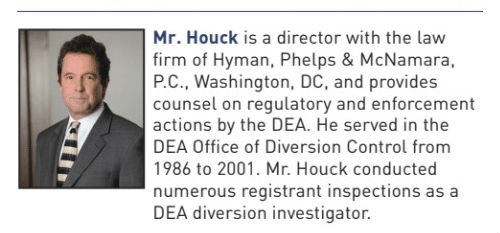
DEA Preregistration and Cyclic Inspections: What Applicants and Registrants Must Know in the Prescription Opioid Epidemic Age
by Larry K. Houck
The United States is in the midst of a prescription opioid abuse epidemic. Deaths from oxycodone, hydrocodone, and other prescription opioids have more than quadrupled since 1999 and those drugs take an average of 44 American lives every day.1 The Drug Enforcement Administration (DEA) has taken measures to combat escalating opioid misuse and abuse. Preregistration inspections of controlled substance applicants and scheduled cyclic inspections of registrants are among the weapons in DEA’s arsenal to ensure that drugs subject to abuse do not end up in the wrong hands. DEA Acting Administrator Chuck Rosenberg, in his Fiscal Year 2017 budget proposal, asked for authorization of $8.9 million to add 55 new positions, including 28 diversion investigators and 10 special agents to conduct regulatory investigations.2 On the same day in March 2016, DEA Deputy Administrator Louis Milione addressed a hearing on the heroin opioid abuse epidemic, noting: “DEA has steadily increased the frequency of compliance inspections of specific registrant categories such as manufacturers (including bulk manufacturers); distributors; pharmacies; importers; exporters; and narcotic treatment pr ograms.”3 In the past, some pharmacists spent their careers never having seen a DEA diversion investigator. In response to the opioid epidemic, DEA has begun conducting scheduled regulatory inspections of pharmacies and other “practitioner registrants,” including hospitals and physicians.
ograms.”3 In the past, some pharmacists spent their careers never having seen a DEA diversion investigator. In response to the opioid epidemic, DEA has begun conducting scheduled regulatory inspections of pharmacies and other “practitioner registrants,” including hospitals and physicians.
This article explains the purpose of preregistration and cyclic inspections and how applicants and registrants should prepare for and manage them.
Congress passed the Comprehensive Drug Abuse Prevention and Control Act of 1970 as amended, commonly known as the Controlled Substances Act (CSA), which established a comprehensive statutory framework to prevent the diversion and abuse of legitimate and illicit controlled substances. DEA is the primary agency responsible for enforcement of the CSA. The agency’s mission is to eliminate illicit controlled substances like heroin altogether but its responsibilities for legal controlled pharmaceuticals is more complex. DEA seeks to prevent, detect, and eliminate the diversion of controlled pharmaceuticals from legitimate channels to illegal use while ensuring their availability for medical, scientific, and industrial purposes. The CSA established a closed system of controlled substance distribution that requires every entity in the chain, including manufacturers, distributors, importers, exporters, pharmacies, practitioners, and hospitals, to account for the drugs they handle. The CSA establishes a classification of drugs based on their potential for abuse relative to their legitimate medical use.4 Scheduling triggers certain registration, quota, recordkeeping, reporting, and security requirements applicable to each controlled substance.
DEA’s Diversion Control Division, formerly the Office of Diversion Control, is the dedicated unit responsible for regulating legitimate controlled substances. Diversion investigators, and now special agents, ensure that registrants comply with the CSA’s regulatory requirements and bring them into compliance when they do not comply. DEA can seek administrative, civil, or criminal action against registrants who fail to comply with the CSA and its regulations. Among the other initiatives DEA has taken to address the opioid abuse epidemic, it has rescheduled drugs such as hydrocodone into more restrictive schedules and has established more restrictive schedule II manufacturing quotas. In sum, DEA has moved its focus from prescribers as the traditional controlled substance gatekeepers to patient access up the distribution chain to pharmacies, distributors, and manufacturers.
DEA diversion investigators rely on site inspections for reviewing compliance and gathering evidence. Preregistration inspections and routine cyclic inspections are the two primary types of regulatory inspections. Investigators may also conduct inspections for a targeted investigation. In 2009 the Diversion Control Division “intensified its regulatory activities to help the registrant population better comply with the CSA and to identify those registrants who violated the CSA and implementing regulations.”5 The agency began conducting more frequent scheduled investigations of “non-practitioners” (manufacturers, distributors, importers, exporters, and narcotic treatment programs) and in greater depth.6 At that time the agency undertook a “renewed focus on regulatory control [that] has enabled DEA to take a more proactive approach on multiple fronts to ensure that DEA registrants are complying with the Controlled Substances Act and implementing regulations.”7
As mentioned above, investigators also now conduct more frequent inspections of pharmacies, hospitals, clinics, and physician, dentist and veterinarian offices. While the frequency, depth, and course of a DEA inspection are outside the control of applicants and registrants, there are things to do to prepare for and manage inspections. With the opioid epidemic pressing DEA to take a more aggressive approach, registrants must be proactively prepared for and manage inspections.
Preregistration Inspections
Diversion investigators conduct mandatory preregistration inspections of non-practitioner applicants and inspect practitioner applicants on an “as needed” basis. Historically, DEA did not conduct preregistration inspections of practitioners, and relied instead on whether they had obtained required state licenses to handle controlled substances. Preregistration inspections help ensure that applicants are legitimate entities able to comply with controlled substance handling requirements, including maintaining adequate security to minimize the risk of theft or diversion. During the inspection, investigators verify that the applicant has obtained all required state and federal licenses to engage in the proposed controlled substance activities. Investigators ensure the accuracy of the information provided by the applicant. They request information about company officers and individuals who will be directly responsible for controlled substance ordering, handling, and security. Although neither the CSA nor DEA regulations provide authority for collecting such information, investigators ask for employees’ full names and addresses, dates of birth, and social security numbers to conduct background checks. DEA views such information as critical in determining whether the applicant will maintain effective controls.
Investigators thoroughly inspect the facility’s physical security, including storage vaults, safes, cages, and alarm systems, to ensure they are appropriate for the business activity, drug schedules, and expected drug quantities. They test alarms and other security system components to ensure that security is adequate and operational. Investigators review the applicant’s controlled substance handling procedures and advise about maintaining the required audit trail for the drugs that they will handle. They review recordkeeping and reporting requirements, including the need to take a complete inventory on the date DEA issues the registration, then biennially. The investigators explain controlled substance receiving and disposition records including Official Order Forms (DEA Forms-222) or DEA’s automated Controlled Substances Ordering System (CSOS) for schedule II drugs and CSOS and invoices for schedule III-V drugs, theft and loss reports, and suspicious order and Automation of Records and Consolidated Ordering System (ARCOS) reporting when appropriate.
Cyclic Inspections
DEA diversion investigators have conducted more frequent and in-depth cyclic inspections over the past few years. Investigators conduct cyclic inspections of non-practitioner registrants, and a smaller number of practitioners, to assess their ongoing compliance with the CSA. DEA headquarters identifies registrants to inspect during the coming fiscal year. In the past, local diversion groups inspected non-practitioners every three to five years. The Diversion Control Division’s “intensified” and “renewed” regulatory focus has increased the frequency of cyclic inspections to once every three years for non-practitioners.8 The agency increased inspections of chemical registrants including manufacturers, bulk manufacturers, distributors, exporters, and bulk importers to every three years, and increased inspections of DATA-waived practitioners to once every five years.9 Local diversion offices also now inspect about 10 practitioners such as pharmacies, every year.
Investigators prepare for cyclic inspections by reviewing previous inspection reports involving the registrant. Investigators review records and reports filed with DEA including DEA-222s and CSOS, ARCOS, and DEA-106 Theft/Loss reports. They scrutinize areas of prior non-compliance to ensure registrants have corrected past deficiencies. Investigators ask state authorities if the registrant has maintained required state licenses, if it has been the target of investigation and for the results of any inspections. Investigators may inquire with local police about whether the registrant has reported thefts or other criminal activity. Investigators consult with DEA headquarters about the registrant’s compliance with required reporting, and review its registration category, status, and authorized controlled substances to assess whether the registrant is conducting unauthorized activities.
Diversion investigators arrive unannounced at the registered facility. They present their DEA credentials bearing their photograph and a written notice of their inspection authority. Two investigators must be present but they may be accompanied by DEA special agents or officers from other federal or state agencies. The investigators ask the responsible employee for informed consent by having them sign a Notice of Inspection (DEA Form-82). Registrants may withhold consent or, if given, can withdraw consent at any time. Withholding or withdrawing consent requires investigators to obtain an administrative inspection warrant or search warrant. Withholding consent will not be well-received, especially if the purpose of the inspection is a routine inspection. Enforcing the CSA by inspecting a registered facility constitutes probable cause for obtaining an administrative inspection warrant.10
The CSA authorizes diversion investigators to inspect “controlled premises,” which are places where registrants may “lawfully hold, manufacture, distribute, dispense, administer, or otherwise dispose of controlled substances or listed chemicals or where records relating to those activities are maintained.”11 Investigators can inspect, copy, and verify required records and reports, inspect finished and unfinished drugs, equipment, containers, labeling, processes, and controls.12
Registrants must understand the reason for any inspection and consult with management before giving consent. Investigators explain the purpose and scope of the inspection at the outset and indicate how they will proceed. Investigators update their file on the registrant by asking personal information about officers and employees who have access to controlled substances. Generally, investigators walk through the facility upon arrival looking for obvious violations, such as controlled substances outside the secure area or doors of the warehouse, cage, or vault propped open.
Registrants must account for all the controlled substances that they handle. Following initial discussions, investigators count certain drugs so they can complete an accountability audit. The accountability audit helps determine whether the registrant has maintained complete and accurate records and effective security. Investigators identify at least two drugs in each schedule to audit. Typically, investigators audit the most diverted drugs in the region. For continuity, they may audit drugs they audited during their last inspection. Investigators conduct six-month audits at a minimum for registrants who have never experienced violations. The audit period for registrants with a “violative history” may cover one year or longer. The audit discloses any variance in the quantity of controlled substances the registrant can account for versus what it is responsible to account for during the audit period. The audit attempts to balance the controlled substances on-hand at the beginning of the period plus receipts against dispositions plus quantities on-hand at the end of the period.
The investigators ask employees to count the audited drugs on-hand or to confirm their counts. They ask employees if they have counted all audited controlled substance quantities. If the business day has begun, the count is labeled “BOB” (beginning of business), and investigators include the drugs already shipped as being on-hand at the end of the audit period. Closing inventory quantities are those at the end point of the audit. The audit’s beginning quantities are taken from a physical count taken at least six months prior for “non-violative registrants” and one year prior for “violative registrants.” Ideally the audit balances. A negative variance can indicate incomplete or inaccurate records or a loss while a positive variance can indicate recordkeeping errors. There is no “acceptable” discrepancy range, but investigators are less-inclined to be concerned about smaller discrepancies.
Diversion investigators are authorized to inspect, copy, and verify required controlled substance records and reports including inventories, and to inspect security systems. They are not authorized to inspect financial data, sales data other than shipment data, or pricing data unless the registrant provides written consent.13 Investigators review required reports and records to ensure that they are complete, accurate, and available for at least two years. (Some states require longer retention periods). It is to the registrant’s benefit to provide all relevant records and reports to investigators immediately if they have not seen them. Registrants with automated records can offer to generate a report of receipt and disposition transactions for the audit period. Every transaction on the automated report should correspond to a particular DEA-222, invoice, packing slip, or other primary record. Investigators verify transactions on the report with primary records.
The investigators review DEA-222s to ensure that they are properly executed, complete and accurate, and the orders were filled within 60 days of the customer executing the order form. Investigators review Powers of Attorney to ensure that individuals ordering schedule II drugs are properly authorized. Investigators review invoices and packing slips to make sure that they are also complete and accurate. Investigators later verify random receipts and sales with the registrant’s vendors and customers. The investigators review other records and reports required to be maintained by the registrant to ensure they are also complete and accurate.
The investigators typically save the facility’s security review for the end of the inspection. Registrants must provide effective controls to guard against controlled substance theft and diversion, and employ specified security depending on business activity and type and quantities of drugs handled. Investigators inspect the overall security system and confirm that each component meets specifications and is operational. They ensure that the posted lists of employees who have access to the warehouse, cage, and vaults are current. The investigators examine storage and work areas, including alarm sensors, locks, and doors to make sure that they are operational. Investigators test the alarm system with the monitoring station and may test before or after operating hours.
DEA regulations do not require investigators to conduct exit interviews with registrant management, but investigators usually provide some feedback at the end of a cyclic inspection. They may not provide all findings until they have reviewed every document obtained during the inspection and the results of the accountability audit. Investigators may recommend what the registrant must do to comply with the CSA and its regulations, and may inform the registrant of the different courses of possible action as a result of their findings. Failure of the investigators to hold a final discussion may indicate they have found violations that warrant enforcement action such as a Letter of Admonition, informal or formal hearing, civil penalty, or administrative action. Registrants may not receive notification of intended actions for several months after the inspection.
Conclusion
DEA is taking a more aggressive approach to identify registrants who are non-compliant with the CSA by conducting more frequent inspections of greater depth. Registrants must understand the purpose of each type of inspection and how investigators conduct them to more proactively prepare for and manage them. Proactivity will help registrants assist investigators conduct more accurate and timely inspections. Knowledge about the inspections will also make registrants better aware of their controlled substance obligations, which benefits everyone.
- Centers for Disease Control and Prevention, Opioid Overdose: Understanding the Epidemic, https://www.cdc.gov/drugoverdose/epidemic/index.html (last visited Sept. 18, 2017); U.S. Dep’t of Health and Human Services, About the Epidemic, https://www.hhs.gov/opioids-about-the-epidemic/index.html (last visited Sept. 18, 2017).
- Statement of the Honorable Chuck Rosenberg, Acting Administrator Drug Enforcement Administration Before the U.S. House of Representatives Committee on Appropriations Subcommittee on Commerce, Justice, Science and Related Agencies, 3-4 (Mar. 22, 2016).
- Statement of Louis J. Milione Deputy Assistant Administrator Office of Diversion Control Drug Enforcement Administration Before the Committee on Oversight and Government Reform U.S. House of Representatives for a Hearing on the Heroin Use and Opioid Abuse Epidemic, 7 (Mar. 22, 2016).
- 21 U.S.C. § 812.
- Controlled Substances and List I Chemical Registration and Reregistration Fees, 76 Fed. Reg. 39,318, 39,324 (July 6, 2011).
- Id.
- Warning: The Growing Danger of Prescription Drug Diversion, Hearing Before the Subcomm. On Commerce, Manufacturing and Trade of the H. Comm. On Energy and Commerce, 112th Cong., 6 (2011)(statement of Michele M. Leonhart, Administrator, DEA, Department of Justice).
- Controlled Substances and List I Chemical Registration and Reregistration Fees, 76 Fed. Reg. 39,318, 39,324 (July 6, 2011).
- Id., at 39,324-25. Under the Drug Addiction Treatment Act of 2000 (DATA 2000), qualified physicians may apply for waivers to treat opioid dependency with approved products scheduled as III – V.
- 21 U.S.C. § 880(d)(1).
- 21 U.S.C. § 880(a).
- 21 U.S.C. § 880(b).
- 21 U.S.C. § 880(b)(4).
Update Magazine
November/December 2017









